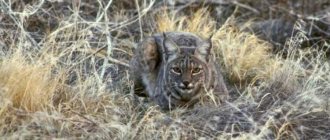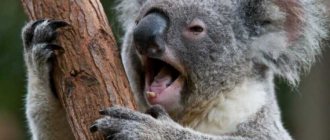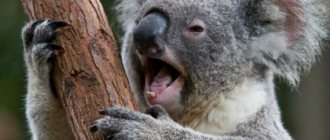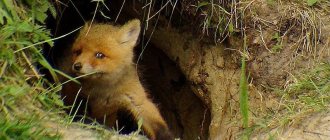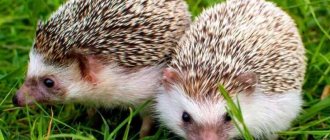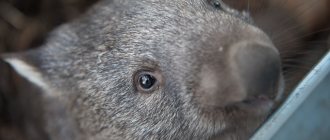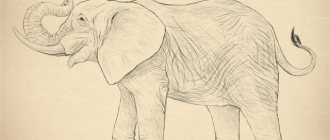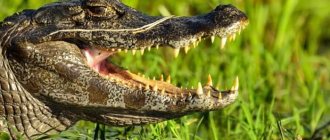Review author: “ZooVita”
For the Chinese, this animal personifies intelligence, cunning, and curiosity. The word "monkey" comes from the Persian "abuzina". Today there are more than 400 species of primates. In the photo of monkeys you can see that they are all different. Animals differ in character, habits, and way of life.
Description, structure, characteristics
Let's start with the fact that the very origin of the name “monkey” is very curious. Until the 16th century, we called the monkey “opitsa”; by the way, the Czechs still call it that way. After the Russian traveler Afanasy Nikitin returned from his famous trip to India, he brought into use the Persian name “abuzina,” literally meaning “father of fornication.” Subsequently, the Persian “abuzina” was transformed into “monkey”.
The body length of a monkey, depending on its species, can range from 15 cm (for the pygmy marmoset) to 2 m (for the gorilla). Also, the mass of a monkey can range from 150 grams for the smallest representatives of the species, up to 275 kg - this is how much huge gorillas weigh.
Many monkeys lead an arboreal lifestyle, that is, they primarily live in trees and, as a result, have a long back, a shortened narrow chest, and thin hip bones. But orangutans and gibbons have a wide chest and massive pelvic bones.
Some monkeys have a very long tail, the length of which can even exceed the size of the body; the monkey's tail acts as a balancer when moving between trees. But monkeys living on the ground have a very short tail. As for monkeys without a tail, all “humanoid” monkeys do not have it (just as humans do not have it).
The body of monkeys is covered with fur of different colors, depending on the species it can be light brown, red, black and white, gray-olive. Some adult monkeys may turn gray with age, and male monkeys may go bald, again much like humans.
Monkeys have mobile, well-developed upper limbs, very similar to our hands, each with five fingers, and monkeys living in trees have short and large fingers, which allows them to comfortably fly from branch to branch.
Monkeys have binocular vision, many of them have black pupils.
The teeth of monkeys are also similar to humans; narrow-nosed monkeys have 32 teeth, and broad-nosed monkeys have 36.
The monkey’s brain is also very well developed; among other representatives of the animal world, only dolphins could compete with monkeys in terms of intelligence. Apes have entire sections of the brain responsible for meaningful actions.
Monkeys communicate with each other using a special signaling system consisting of facial expressions and sounds. The most “chatty” among them are monkeys and capuchins; they have rich facial expressions and are able to express a wide range of feelings.
Social behavior
Monkeys are social animals, which means they usually live in packs. They have formed their own language in which they communicate, talk about danger and convey their emotions. It is believed that in the language of monkeys there are several dozen sounds that convey information about current events. For example, scientists have documented that rhythmic clicking sounds signal the approach of a leopard, while rapid whistling sounds signal the approach of a snake.
The hierarchy within communities is quite complex. At the head is a leader, whose place is taken by the most aggressive and decisive male. However, this post does not always go to the strongest primate; a significant role in obtaining such a place is given to the respect that he must earn in the community.
The responsibilities of the leader boil down to protecting the flock from enemies, organizing resistance or escape if it is impossible to fight back. The leader is the first to have the right to touch the food and choose the best pieces. After him, other monkeys approach the food; their order is determined by their hierarchical position in the group.
The leader is selective about the members of his group. However, the basis of the relationships of any community is mutual assistance and cooperation, which is due to the presence of social and friendly ties. It is difficult to find an analogue of such relationships in the animal world.
Monkeys communicate with their babies.
Recommended by topic
Fox Panda Lynx
Monkeys can communicate with each other in a rather unusual way - through grooming. They look for insects stuck in the fur, remove specks, dirt, hairs, etc. For primates, this is not only a way of maintaining hygiene, but also a social ritual. With these actions they show their sympathy, apologize, demonstrate submission, etc. The leader allows only special females to approach him, which is also typical for other influential members of the group who occupy a high position.
Parents often groom their young, but not all members of the group can be trusted to do the same. Only those monkeys with whom the parents have the strongest social ties have access to other people's children. Their “friends” can take care of the babies in the absence of their parents and in the event of their death.
In most cases, monkeys behave quite peacefully and prefer not to conflict with neighbors who share the same territory with them.
Monkey intelligence
Scientists have long been interested in the intellectual abilities of monkeys. As a result of experiments, they were able to establish that apes have certain rudiments of intelligence, which was especially well studied in the example of chimpanzees. However, chimpanzees do not have a vocal apparatus that would allow them to make sounds similar to human conversation. However, they replace their absence with gestures and symbols that help them understand each other.
Question to the expert
Can monkeys think?
Numerous experiments on this matter show the high intellectual and mental development of monkeys, characterized by a high degree of receptivity, ingenuity, and the rudiments of thinking. At the same time, the psyche of monkeys, their perception of reality differs in many ways from that of humans. They do not have a language, they do not know how to think abstractly and do not work. Therefore, it is impossible to say that monkeys can think in the traditional sense of the word.
In their natural habitat, primates gather in groups, within which multi-stage social relationships inevitably form. For them, the presence of complex forms of behavior is considered normal, which is due to the ability of monkeys to experience feelings similar to humans.
In addition, monkeys are very inventive, which indicates their intellectual abilities.
For example, Japanese macaques living in the northern regions of Japan sit in hot springs to warm up when frost approaches.
Every day, scientists are learning more and more about the abilities of monkeys, which helps people understand them better. Today it is known for certain that they experience not only basic emotions such as fear, grief, and social involvement in their group. Monkeys are capable of more complex feelings: shame, remorse, empathy, a sense of equality and justice.
For example, during one experiment, a bonobo monkey received a reward for completing a task less than its relatives (carrots instead of grapes). As a result, she refused to work until she received her due portion of grapes. Scientists explained this instinct by the principle of distribution of prey within a group after a collective hunt.
Despite the fact that many emotions have developed as a result of certain evolutionary features, they are experienced as deeply as basic feelings.
Lifestyle
Monkeys live in small families and, according to their lifestyle, are divided into arboreal monkeys, living in trees, and terrestrial monkeys, living on the ground. Monkeys tend to be sedentary and rarely leave their territory.
Sometimes there are clashes between male monkeys, with the goal of resolving the answer to the question “who is the main male here,” although often such clashes are limited to a demonstration of the strength of each male and do not lead to a real fight.
Nutrition
Monkeys are omnivores, and their diet depends on the species and also the habitat. Tree monkeys eat everything they can get in the trees -
leaves, various fruits, nuts, and sometimes insects.
Land monkeys eat rhizomes and shoots of plants (for example, ferns are a favorite delicacy of the gorilla), fruits (figs, mangoes, and, of course, bananas). Also, some monkeys know how to fish and happily eat shellfish, rodents,
lizards, grasshoppers, beetles and other small animals.
Although there are species of monkeys that eat only one, specific food, for example, Japanese stump-tailed macaques are pure vegetarians and feed exclusively on tree bark, and the crab-eating macaque, as its name suggests, feeds on crabs.
Natural enemies
In the wild, the most common natural enemies are:
- Leopards.
- Tigers.
- Cheetahs.
- Lions.
- Jaguars.
- Boa constrictors.
- Pythons.
- Crocodiles.
For the same species that live in South America, birds of prey like eagles, hawks and kites also pose a danger.
In addition, human activities have a great influence on monkeys. People use monkeys for laboratory experiments, in research institutes, and place them in nature reserves, removing them from their natural environment. In addition, people are destroying the natural habitats of primates, reducing their population. For example, in China the number of langurs has sharply decreased due to large-scale deforestation. As a result, the government had to create additional protected areas.
The largest species of monkeys have almost no natural enemies. However, they often die as a result of collisions with aggressive neighbors from their own group.
Also, monkeys, like people, are susceptible to a number of diseases from which they can die. These include infectious diseases such as tuberculosis, sore throat, influenza, etc.
Almost all species of monkeys are dependent on the manifestations of various negative factors, and therefore they are good at recognizing danger, warning their relatives about it.
Types, photos and names
In general, all types of monkeys can be divided into:
Regarding different species of monkeys, zoologists have separately distinguished the species of anthropoid apes, species of small monkeys, etc. In general, there are more than 400 species of these primates in nature, below we will describe the most interesting of them.
Black Howler
It is a member of the spider monkey family. It is so named due to the fact that it produces characteristic sounds that can be heard at a distance of up to 5 km. Male black howler monkeys are covered with black fur and fully justify their name, but female black howler monkeys are not black at all, their fur is yellow-brown or olive in color. The length of this monkey is 56-67 cm, with a weight of 6.7 kg. The black howler monkey lives in South America, in countries such as Paraguay, Brazil, Argentina, and Bolivia.
Mourning capuchin
Belonging to the prehensile-tailed family, the capuchin is an arboreal monkey that lives in trees. The weight of a capuchin is 3 kg. It has a brown or gray-brown color. A very curious feature of this species of monkeys is their habit of rubbing themselves with poisonous centipedes (
centipedes) to protect against blood-sucking insects. Mourning capuchins live in the crowns of tropical forests in Brazil and Venezuela.
Crowned monkey
It got its unusual name thanks to its gray color with shades of blue and a white stripe of fur that runs over the eyebrows like a crown. The body length of the crowned monkey is 50-60 cm and weighs 5-6 kg. Monkeys live in African forests from the Congo River basin to Ethiopia and Angola.
White-handed gibbon
Belongs to the apes of the gibbon family. It is 55-65 cm in length and weighs 5-6 kg. The coat color of the white-handed gibbon can be black, sand or brown, but its hands are always white, hence the name. These gibbons live in the tropical forests of China and the Malay Archipelago.
Eastern gorilla
Gorilla is the largest ape in the world. The average size of a gorilla is 185 cm with a body weight of 180 kg. Although sometimes you come across larger gorillas, weighing up to 220 kg. These huge monkeys are distinguished by their large heads, broad shoulders, and open chests. The color of the gorilla's coat is black; in old age, gorillas, like people, can turn gray. Despite their menacing appearance, gorillas prefer to eat grass and plant shoots rather than hunt game. Gorillas live in the equatorial forests of Central and Western Africa.
Pale Saki
He is also a white-headed saki, in our opinion this monkey has the strangest appearance - the black color of his fur contrasts brightly with the white color of his face. The size of pale saki is 30-48 cm and weighs 2 kg. This is an arboreal monkey living in the forests of Brazil, Venezuela, and Suriname.
Hamadryad
He is also a frog baboon, a species of narrow-nosed monkeys that spend their entire lives exclusively on the ground. It is also a fairly large monkey, the body length of the hamadryas is 70-100 cm, weight 30 kg. It also has an unusual appearance - long hair on the shoulders and chest forms a kind of fur cape. The hamadryas lives in both Africa and Asia in a number of countries, such as Somalia, Ethiopia, Sudan, Yemen.
Proboscis
The proboscis monkey, also known as kahau, belongs to the monkey family. A striking feature of this monkey is its large nose, which the monkeys even have to hold with their hands while eating. It has a yellow-brown color. The size of the proboscis monkey is 66-77 cm and weighs 15-22 kg. It also has a long tail, which is equal in size to the length of their body. These unusual species of monkeys live exclusively on the island of Borneo.
Japanese macaque
Living in the northern part of the Japanese island of Honshu, this monkey is a real calling card of these places. The size of the Japanese macaque is 80-95 cm, weight 12-14 kg. These monkeys have bright red skin, which is especially noticeable on their face and buttocks, which are devoid of fur. Macaques living in northern Japan survive the cold winter months in special thermal springs, warming up in their hot waters (and at the same time attracting crowds of tourists from all over the world).
Sumatran orangutan
The Sumatran orangutan is a fairly large monkey, its size reaches one and a half meters and weighs 150-160 kg. In terms of size, the orangutan ranks second after the gorilla. It has well-developed muscles, a massive body covered with red hair, and is an excellent tree climber. The orangutan's face has fat pads located on the cheeks, and the beard and mustache give it a very funny look. The charismatic Sumatran orangutan lives exclusively on the island of Sumatra.
common chimpanzee
For some reason, monkeys are most associated with chimpanzees, which are the most characteristic representative of the monkey kingdom. Chimpanzees are also relatively large monkeys, their body length is 140-160 cm and their weight is 65-80 kg, that is, they are the same size as humans. The body of a chimpanzee is covered with black fur. It is also very curious that these anthropoid apes are the only ones who thought of creating a kind of tools that facilitate the process of obtaining food, they are able to sharpen the ends of sticks, turning them into imitation spears, they can use stone leaves as traps for insects, etc. Without a doubt, chimpanzees are the most intelligent among the apes, and if Darwin’s theory is right, then they are the ones who are in the closest family relationship with us humans. Chimpanzees live mainly in Central and Western Africa.
Pygmy marmoset
And finally, it was impossible not to mention the pygmy marmoset - the smallest monkey in the world. Its length is only 10-15 cm, weight – 100-150 grams. They live in the forests of South America, feeding exclusively on tree sap.
Great apes
Another way to get closer to the truth is to look at animals whose structure is similar to ours. These animals, which belong to the class of primates and are called apes, are very similar to us. DNA analysis has shown that human genes are 98% identical to those of chimpanzees and gorillas. The anatomical structure and biochemical processes in our bodies are almost completely identical.
It is for this reason that researchers, after experiments on mice and guinea pigs, are conducting the latest testing of new drugs on chimpanzees. If the drugs work on them and do not harm them, it can be considered almost proven that they will act in the same way on humans.
Apes live in tropical rainforests and eat whatever they can find. In tropical forests there is no pronounced change of seasons. Plants can bloom, bear fruit, produce seeds and germinate all year round. However, in this climate the dry season alternates with the rainy season, which means there are periods of abundance and scarcity of food.
Apes occupy a very vast territory. They move around it like nomads in search of food. Every evening they build a nest in trees using bent and broken branches. Apes are unclean creatures that leave behind piles of excrement and garbage. They, like the forest nomads, never had the need to carefully manage their household.
Reproduction
Monkey reproduction occurs throughout the year and each species has its own individual characteristics. Puberty in monkeys usually occurs at 7-8 years. Some species of monkeys are monogamous and create permanent families for life, others, such as capuchins, on the contrary, are polygamous, so female capuchins mate with several males, and the males do the same.
A monkey's pregnancy can last from 6 to 8.5 months, again depending on the species. Usually one baby is born at a time, but there are species of monkeys that can give birth to twins.
Little monkeys, like real primates, are fed with their mother's breast milk, and the period of feeding also varies from one monkey to another. The female gorilla feeds her cubs the longest - this period lasts up to 3.5 years.
Lifespan
Under natural conditions, the normal lifespan of monkeys is considered to be 50 years. Living in captivity, primates can live several years longer if the conditions meet their needs. The lifespan of different species differs, which is determined by their habitat.
Not all individuals reach the age of average life expectancy. They are at risk from injury, predatory animals or human activity.
Monkeys go through stages of maturation similar to humans, especially those that belong to the ape species. For example, chimpanzee cubs are dependent on their mother until they are 5 years old, and only after reaching this age do they begin to be more independent. At the age of 8, adolescence begins; at 16, the monkey is considered already a sexually mature individual. At this moment, they enter a new stage of life, in which they, matured and independent, enter adulthood.
Keeping at home
Despite the fact that monkeys are wild creatures, they are nevertheless very easy to train, get used to captivity, and, under favorable conditions, feel quite comfortable in zoos. True, keeping a monkey at home is not the best idea, they are terrible mischievous and restless, and if you have already decided to have a pet monkey, then you should be prepared for it to create real chaos in your home. To prevent this, the monkey can be kept in a spacious cage.
You can feed the monkey fish, chicken or turkey, boiled eggs, vegetables, nuts, and fresh fruits.
How many pairs of chromosomes do chimpanzees have?
Chromosomal differences between primate species are generally well understood. For example, it has long been known that humans have 46 (or 23 pairs) of chromosomes, while chimpanzees, gorilla and orangutans have 48 (or 24 pairs).
Interesting materials:
How to snap to guides in Illustrator? How to return the action to forward in Illustrator? How to make multi-colored text in Insta stories? How to make your own Geolocation on Instagram? How to make one photo into two on Instagram? How to make a profile header on Instagram? How to swipe on Instagram? How to make it relevant on Instagram? How to take a long photo on Instagram? How to take a photo on Instagram without hands?
Interesting Facts
- Some species of monkeys are very clean and spend almost the whole day caring for their appearance.
- During the development of astronautics, 32 monkeys have already visited space.
- Spider monkeys have such a developed and strong tail that they can easily hang on a tree branch with its help alone.
- A group of American scientists managed to teach a female gorilla a certain number of words from the language of the deaf and dumb, after which she was able to quite successfully communicate with people.
Summary of the diet of great apes
The main features of the great ape diet are high in volume, low in calories, high in microelements and fiber, and low in fat. It does not contain: grains and dairy products, fish and starch. There is practically no meat. Does this remind you of anything?
Apes spend quite a lot of time eating - up to 30% of the entire waking period, and gorillas even more. Their feeding pattern is that they go out in the late morning in search of food and then “catch” something at regular intervals. In other words, they eat little but often. It would be worth repeating once again that they are supported by low-calorie foods. Proof of this is at least the fact that they hardly drink.
The food they consume consists of more than 80% water. Therefore, the great ape is able to maintain a positive fluid balance without consuming water.
| An astronaut chimpanzee named "Ham" takes a piece of fruit. He is glad to be returning to Earth after his flight on the Mercury program. Ham paved the way for Alan Shepard into space (Photo courtesy of NASA) |
Video
And in conclusion, an interesting documentary about monkeys from the Discovery Channel - “Monkeys on the Warpath”
Author: Pavel Chaika, editor-in-chief of Poznavaika magazine
When writing the article, I tried to make it as interesting, useful and high-quality as possible. I would be grateful for any feedback and constructive criticism in the form of comments on the article. You can also write your wish/question/suggestion to my email [email protected] or Facebook, with respect, the author.
Author page
They use mutual grooming to strengthen their relationship.
Photo: Cecilia Jørgensen
For monkeys, cleaning the fur of their relatives from insects, dirt, dead skin, parasites and other debris is not due to personal hygiene, it is a way of expressing affection. Daily grooming rituals not only keep the monkeys healthy, but also strengthen their social bonds. Mutual grooming also helps them make peace after a fight or build good relationships with new group members.
The researchers discovered another benefit of this process. When vervet monkeys brush each other's skins, they fluff up the fur and thicken the fur. After careful care, the insulating capacity of vervet skin increases by 50%.

